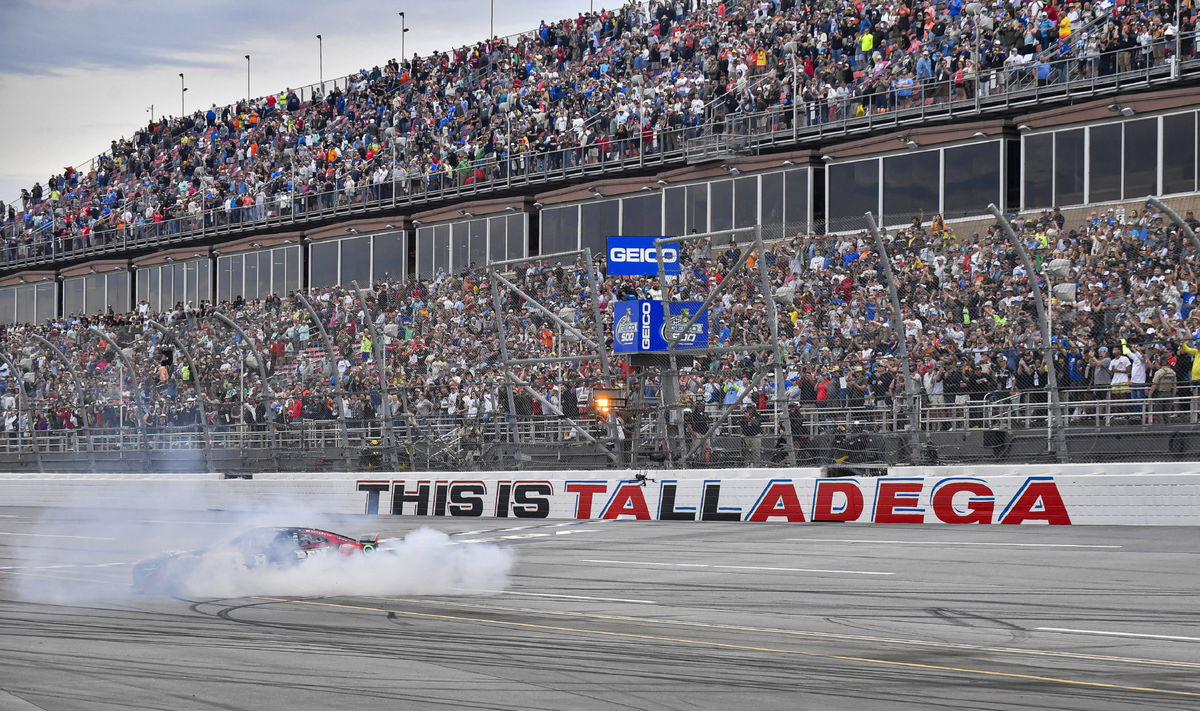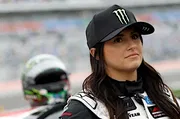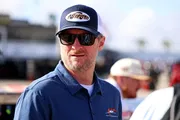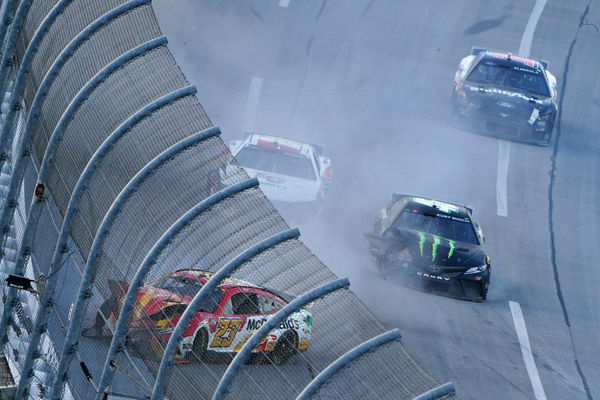
Imago
LINCOLN, AL – APRIL 23: Kyle Busch 8 does a burnout in the McLaren Custom Grills Chevrolet after winning the GEICO 500 in the NASCAR, Motorsport, USA Cup Series on Sunday, April 23, 2023 at Talladega Superspeedway in Lincoln, AL. Photo by Austin McAfee/Icon Sportswire AUTO: APR 23 NASCAR Cup Series GEICO 500 EDITORIAL USE ONLY Icon230423021

Imago
LINCOLN, AL – APRIL 23: Kyle Busch 8 does a burnout in the McLaren Custom Grills Chevrolet after winning the GEICO 500 in the NASCAR, Motorsport, USA Cup Series on Sunday, April 23, 2023 at Talladega Superspeedway in Lincoln, AL. Photo by Austin McAfee/Icon Sportswire AUTO: APR 23 NASCAR Cup Series GEICO 500 EDITORIAL USE ONLY Icon230423021
54 years ago, NASCAR found a myth on 3366 Speedway Boulevard in Lincoln, AL, and these days, we know it simply as the Talladega Superspeedway. This 2.66-mile behemoth is home to many stories, some of triumph, others of gut-wrenching tragedy. For instance, Bill Elliott set NASCAR’s fastest-ever lap on this racetrack at the 1987 Winston 500, registering a top speed of 212.809 miles per hour (342.483 km/h) in a record 44.998 seconds.
Watch What’s Trending Now!
Alternatively, Talladega has witnessed the biggest multi-car wreck in the modern era when a staggering 31 cars got involved in the ‘Big One’ at the 2002 Aaron’s 312 Busch Series race. Hence, to call its multi-faceted drama a mere myth is quite disrespectful to a legend of the game. Regardless, call it what you may, but on July 25, 1993, lurking in the shadows of its towering banks, a sinister force seemed to thirst for blood, searching for a casualty.
Although everyone involved in the incidents to follow emerged relatively unharmed and, thankfully, breathing, the mystery of that day certainly made an enormous impact on the current state of things in NASCAR.
ADVERTISEMENT
The mystery of the 1993 DieHard 500 at Talladega Superspeedway
Only a few weeks before the incident, on July 12th, 32-year-old Davey Allison had crashed his helicopter into the infield of Talladega and lost his life the following morning at the Carraway Methodist Medical Center in Birmingham. As a matter of fact, before the start of the 1993 Diehard 500, the late Davey Allison received a heartfelt tribute with everyone’s utmost respect at the same track responsible for his death only a few days earlier.
When the green dropped, Bill Elliott, pole winner for that race, faced a hefty challenge from California racing icon, Ernie Swervin’ Irvan from the get-go. Yet, at the end of the scheduled 188 laps, a certain Man in Black driving his signature #3 Chevy found his way to Talladega’s victory lane for only the 6th time in his gloried NASCAR career. This win would be Dale Earnhardt’s last of the season and it massively helped him edge out Rusty Wallace for his 6th career Bill France Cup. But on the flip side of that coin of gold, lay bare two shocking tragedies that forever altered the way people viewed this race.
ADVERTISEMENT
Jimmy Horton & Stanley Smith. These two lesser-known drivers hailing from vastly differing races of life have registered around 70 race appearances combined in the Winston Cup Series. Neither achieved a top-10 finish in the premier tier. And if some would even want to call it that, Horton & Stanley were ‘backmarkers.’ The highest-finishing driver amongst them was Horton, whose best-ever finish was a couple of P13 finishes at Atlanta and Talladega respectively, in back-to-back seasons.
Racing your car to a top-13 finish at Talladega back then, when safety wasn’t as closely regulated as it is now, was no simple task. And it wasn’t simple at all for either Horton & Stanley Smith on July 25th at the 1993 Diehard 500. Starting from P24 and P35 respectively, the duo got entangled in a massive wreck early on Lap 69 which also involved the likes of Harry Gant, Rick Mast, and Kenny Wallace. But it was Horton, and especially Smith, who bore the majority brunt of the whole incident.
ADVERTISEMENT
Headed into Turn 1 of the tri-oval, a car leaned a bit too hard on the right flank of Stanley Smith’s #49 self-owned Chevy at 180mph+. This caused Smith to lose control momentarily and shoot down the racetrack. Nobody was ready for what followed next, as a domino effect of wrecks occurred around the centerpiece. Jimmy Horton’s #32 Chevy flipped side-over-side and eventually barreled down the other side of the banking and out of the racetrack after Smith’s rogue #49 gave it a big unintentional hit alongside three other cars that went straight into the wall. The cars acted as somewhat of a ramp and pushed Horton’s already airborne car over the confines of Talladega Turn 1. The absence of any catchfence on that portion of the track did not help Horton’s case any further.

USA Today via Reuters
Oct 2, 2022; Talladega, Alabama, USA; NASCAR Cup Series driver Tyler Reddick (8) leads the field during the Yellawood 500 at Talladega Superspeedway. Mandatory Credit: John David Mercer-USA TODAY Sports TPX IMAGES OF THE DAY
When the dirt settled, Horton’s #32 found its resting place in a parking lot on the other side of the track. Impressively, the New Jersey native got out of his car with minimal bruises and no life-threatening injuries. In fact, Horton was so chill about the whole incident that he was actively engaging in banter with the media, who had gathered at the spot later. “I knew I was in trouble when the first guy who got to the window after the crash was holding a beer,” he had said, at that moment.
ADVERTISEMENT
However, everything was not as rosy over on Stanley Smith’s side. After losing control of his car and accidentally flipping Horton, Smith was left spinning in the middle of the racetrack, unable to avoid getting collected in one of those unforgiving Talladega ‘Big Ones.’ Facing incoming traffic sideways, UPI had reported back then that Ritchie Petty, nephew of Richard “King” Petty, was the first to hit Smith’s car head-on. This sent the #49 nose-first into the wall. Everyone else was safe, but the #49 driver and his vehicle slowly and ominously came to a halt on the apron. Stanley’s self-owned car was demolished, his race visibly over. But many let out a silent gasp when his window-net did not come down instantly and a slow flame made its way from the mangled remains of the Chevy’s underbody.
When track safety officials reached the mangled car #49, they encountered a harrowing sight. Smith’s white firesuit had turned red from all the blood the man had lost in those brief few moments. This incident truly emphasized the split-second risk aspect of NASCAR racing to the fullest at the time as Stanley Smith had suffered from a petrifying basilar skull fracture. For those unfamiliar, this feared type of fracture was also responsible for the death of Dale Earnhardt at Daytona International Superspeedway on February 28th, 2001. In simpler words, Stanley’s skull had cracked from ear to ear.
Thankfully, Smith had a pulse, and he was breathing. But it was only a matter of inches before something unprecedented could have happened that day. In all honesty? Stanley Smith was lucky that day. Figuratively, one can also make a case for the very earth he grew up on as a Chelsea, Alabama lad, sparing his life at Talladega that day. Regardless, Smith remained in a comatose state for 40 days straight after the incident. Ironically, ambulances rushed him to the same Birmingham hospital where Davey Allison drew his last breath only days earlier. Smith underwent multiple surgeries. The left side of his face suffered paralysis from the damage, serving as a reminder of that horrific day for the rest of his life.
ADVERTISEMENT

Imago
TALLADEGA, AL – APRIL 22: Blaine Perkins ( 02 Ollie s Bargain Outlet Our Motorsports Chevrolet) crashes on the back stretch during the running of the NASCAR, Motorsport, USA Xfinity Series Ag-Pro 300 on April 22,2023 at Talladega SuperSpeedway in Talladega, AL. (Photo by Jeff Robinson/Icon Sportswire) AUTO: APR 22 NASCAR Xfinity Series Ag-Pro 300 EDITORIAL USE ONLY Icon2304223002636
After he finally regained consciousness, Smith never raced in the Cup Series again. He found happiness later in life racing in the regional scenes and even won a NASCAR Southeast Series race at the Kentucky Speedway. Stanley Smith passed away on December 9, 2020, at 71. He succumbed to an interstitial lung disease, survived by his wife and three children. Although his racing career wasn’t as shiny or glorious as the Earnhardts or the Irvans of that time, Stanley’s story will forever resonate with the true blue grit of stock car racers.
As for Jimmy Horton, he is still alive and kicking, and, presently, racing dirt modifieds weekly at the Orange County Fair Speedway. Horton recently received his induction into the Northeast Dirt Modified Hall of Fame only this year. He did not race too long in the Cup Series either, and he made his last appearance two years later at Pocono. In the end, their story came through a full circle, as these two seemingly unknown drivers were partly responsible for forcing two of the biggest changes in NASCAR in recent times concerning safety.
ADVERTISEMENT
Top Stories
Florida Police Arrest Millionaire NASCAR Veteran Over Disturbing Public Misbehavior

Denny Hamlin Demands Immediate Apology From FOX Broadcaster After Michael Jordan’s Lawsuit Triumph

Hailie Deegan & Others Speculated to Fill NASCAR Seat After Star Driver’s Ugly Exit

Departing NASCAR Star’s Father Pens Emotional Note After Parting Ways with Dale Jr.

Dale Jr. Details NASCAR’s Massive Blunder in Savage Takedown of Leadership Decisions

Catchfences and roof flaps: an urgent response to danger
Starting in 1994, NASCAR made roof flaps mandatory for all cars. This aerodynamic mod aimed to keep the car grounded while preventing flips after heavy contact. These days, they are a staple of the Next-Gen cars and that is visible through the fact that the number of cars going airborne and spinning has considerably reduced in modern times. But that wouldn’t be all! A separate incident involving Alabama Gang member, Neil Bonnett changed the way how fans watch a race these days at the Talladega Superspeedway.
On lap 132, Ted Musgrave’s #55 Ford made contact with Bonnett’s one-off #31 RCR entry to send him airborne toward the catchfence, protecting the crowds along the frontstretch. This was Bonnett’s big return to the Winston Cup on the biggest track of the NASCAR calendar. Nine spectators got injured in the crash, but Neil walked away unharmed and called it a day from the CBS booth after finishing his race early at 34th. Following these incidents at 1993 Talladega, NASCAR decided to amp up its crowd protection services after way too many close calls.
ADVERTISEMENT

ADVERTISEMENT
The sanctioning body built catchfences all across Talladega’s 2.66-mile layout and not just in the audience areas. Soon, the entire track was fitted with sheet metal, separating the outsides from the action for safety purposes. This helped Ricky Craven at the Winston Select 1996 when he found himself in a 14-car accident that sent his car airborne at nearly the same spot as Horton’s crash in 1993. Craven’s savior that day was the new catchfence installed at Talladega in the wake of Horton & Bonnett’s respective crashes three years ago.
Sadly, only months since that eerie DieHard 500, Neil Bonnett lost his life at the 1994 Daytona 500 after colliding with the wall head-first on Turn 4 in his Phoenix Racing #51 Chevy. From those tiny roof flaps and reinforced catchfences to the HANS device, NASCAR has taken many steps forward to ensure higher levels of driver safety in the year 2024. Having that said, how can the sport become safer for everyone involved? Let us know your suggestions in the comments below!
ADVERTISEMENT
ADVERTISEMENT
ADVERTISEMENT

